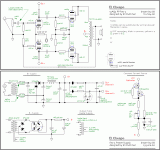Hello everyone!
I recently acquired a few vacuum tubes (~6 ECC81/ECC82) and decided to make a tube amp. I have a solid background in electronics but have never worked with tubes before.
I've set my sights on a simple 5 Watt amp with pre-amp, equalizer and output stages and am really excited to get started (and just picked up a copy of Morgan Jones' book.) But, nothing beats learning from experience and I know you guys have plenty of that!
So, what advice would you give a beginner like me?
I recently acquired a few vacuum tubes (~6 ECC81/ECC82) and decided to make a tube amp. I have a solid background in electronics but have never worked with tubes before.
I've set my sights on a simple 5 Watt amp with pre-amp, equalizer and output stages and am really excited to get started (and just picked up a copy of Morgan Jones' book.) But, nothing beats learning from experience and I know you guys have plenty of that!
So, what advice would you give a beginner like me?
Read MJ's book.
Use Google (other search engine are available).
Don't believe everything you read.
Use Google (other search engine are available).
Don't believe everything you read.
way back in the mists of time (1989), I started with a Dynaco 70 amplifier. I had a coupling cap lead break and had to replace it myself. My source for tubes couldn't always come through, so I rewired the 7199 socket to use the more common 6U8A.
My first tube preamp - a Dynaco PAS, I found the schematic and figured out how to bypass the tone controls.
Long story short, it helps to first modify/fix existing gear to gain an understanding on how they are built. It was a few years of playing around with used vintage stuff that I decided to build my own. A kit is also a good place to start.
My first tube preamp - a Dynaco PAS, I found the schematic and figured out how to bypass the tone controls.
Long story short, it helps to first modify/fix existing gear to gain an understanding on how they are built. It was a few years of playing around with used vintage stuff that I decided to build my own. A kit is also a good place to start.
Look at George Anderson of tubelab.com 's offerings. He has 3 boards, with 2 SE one of which takes DHT tubes and a EL84 PP board which can be had with parts for $100 less tubes, transformers, and enclosure Chassis.
You can pick the Output Transformers to your budget and sonic qualities you desire.
He has a form here and there is lots of help from him and others.
For the popular EL84 PP amp or any other PP EL84/7591 amp add Dave Gillespie's EFB mod for improved tube life, sonics, and power.
Randy
You can pick the Output Transformers to your budget and sonic qualities you desire.
He has a form here and there is lots of help from him and others.
For the popular EL84 PP amp or any other PP EL84/7591 amp add Dave Gillespie's EFB mod for improved tube life, sonics, and power.
Randy
Eli I forgot about that amp! You should say that Jim McShane offers a kit of parts for it, less transformers and chassis!
Regards,
Randy
Regards,
Randy
I've been out of the tube world for 40+ years, just getting my feet wet again. Just figuratively..avoid wet feet and high voltage.
I finally just got an old analog-movement VTVM. I'd advise to get one sooner than I did.
I finally put two leads and alligator clips on a resistor to drain power supply caps. I'd advice to make one sooner than I did.
I finally made a jig to hold a chassis and be able to filp it while running. You don't need one of those right away.
Pick up some wooden or plastic chop sticks for poking around.
You'll find yourself collecting resistors in a whole new higher range.
Enjoy! The best part is that things don't blow up in a femto-second like some solid state components. First they glow different colors, maybe even arc, and you still might salvage the expensive parts.
I finally just got an old analog-movement VTVM. I'd advise to get one sooner than I did.
I finally put two leads and alligator clips on a resistor to drain power supply caps. I'd advice to make one sooner than I did.
I finally made a jig to hold a chassis and be able to filp it while running. You don't need one of those right away.
Pick up some wooden or plastic chop sticks for poking around.
You'll find yourself collecting resistors in a whole new higher range.
Enjoy! The best part is that things don't blow up in a femto-second like some solid state components. First they glow different colors, maybe even arc, and you still might salvage the expensive parts.
- Status
- Not open for further replies.
- Home
- Amplifiers
- Tubes / Valves
- Tube Tips/Tricks for beginners
